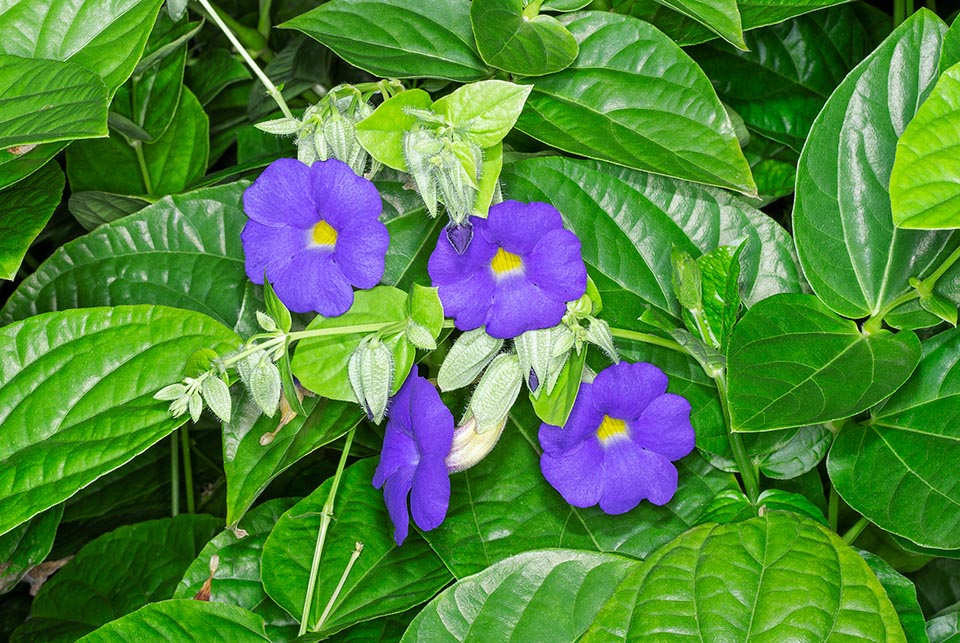Family : Acanthaceae

Text © Pietro Puccio

English translation by Mario Beltramini
The species is native to tropical eastern Africa (Democratic Republic of the Congo, Kenya, Sudan and Uganda), where it lives in the thickets, savannahs and at the margins of the forests, between 800 and 2200 m of altitude.
The genus is dedicated to the Swedish botanist Carl Peter Thunberg (1743-1828), the species of its collector, the English botanist Edward Battiscombe (1874-1971).
Common names: blue boy, blue clock vine, blue glory vine, stormy sky vine (English).
The Thunbergia battiscombei Turrill (1915) is an evergreen perennial herbaceous species with woody base (suffruticose), rarely climber, with 0,5-3 m long stems, usually tetragonal. The leaves, on a 1-3 cm long petiole, are simple, opposite, elliptic to obovate-elliptic with apiculate to obtuse apex, subcordate base, entire margin and pronounced veins, of glossy dark green colour, 8-16 cm long and 6-9 cm broad. Inflorescences, on a 3-5 cm long peduncle, axillar racemose, 10-20 cm long, carrying about 10 infundibuliform flowers, on a 1-1,5 cm long pubescent pedicel, of bright dark blue colour with yellow throat opening in succession. Campanulate calyx, 1-3 mm long, with about 8 teeth, pubescent, hidden by two ovate-elliptic bracteoles with acute apex, of pale green colour, pubescent on both sides, 2-2,5 cm long and about 1 cm broad. Infundibuliform corolla with slightly oblique tube, 4-5 cm long, 5 lobes, 1-1,5 cm long and 1,5-2 cm broad, 4 stamens, 1,2-1,6 cm long, superior globose ovary and 2-3 cm long style.

Native to eastern and tropical Africa the Thunbergia battiscombei is an evergreen perennial herbaceous species with woody base, rarely climbing, and 0,5-3 m long stems, usually tetragonal. The splendid flowering, of intense and luminous dark blue colour, is unequalled. Cultivable as annual in the non-tropical climates © Giuseppe Mazza
The fruit is a capsule globose at the base, of 0,8-1 cm of diameter, with at the apex a 1,5-2 cm long “beak”, containing 2-4 globose seeds, of 0,6-0,8 cm of diameter, of pale brown colour.
It propagates by seed, put in draining organic loam aerated and maintained humid, but without stagnations, at the temperature of 22-24 °C; due to the precocity of the flowering it may be grown as annual, in the less favourable climates, sowing it in a protected environment in late winter and transferring it in the open in early summer. It reproduces also by division and by herbaceous cutting in summer in sandy soil.
Species with copious and almost continuous flowering of unequalled intense and luminous dark blue colour, cultivable in the tropical and subtropical gardens in full sun or slight shade for fences, borders or leant on lattices and enclosures or as drooping from walls and escarpments. Its cultivation may be tried also in the mildest warm temperate climates, where it can stand temperatures around the -4 °C, with appropriate protection of the root system, losing the aerial part, but re-vegetating in spring. It is not particular about the soil, provided draining, acidic to slightly alkaline, maintained almost constantly humid. Due to the rather contained dimensions it is suitable for being cultivated in pot, even if suspended, in soil rich of organic substance with addition of coarse sand or agriperlite per a 30 %, for the decoration of terraces and balconies, where the climate allows, or luminous greenhouses and verandahs, with lowest winter temperatures not under 15 °C. Regular and abundant watering during the vegetative period, more spaced in winter, but without ever allowing the substratum to dry up completely, and fertilizations, in spring summer, with a product specific for plants in pot.
→ To appreciate the biodiversity within the family ACANTHACEAE please click here.
